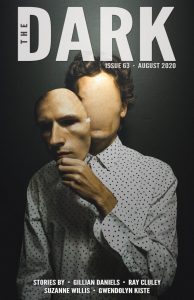Paula Guran Reviews Short Fiction: The Dark, Nightmare, Uncanny, and Shoreline of Infinity
 The Dark 7/20, 8/20
The Dark 7/20, 8/20
Nightmare 8/20, 9/20
Uncanny 7-8/20
Shoreline of Infinity #18
Although I’m writing this in the heat of summer, by the time you read it autumn will be beckoning with fictional chills as well as cooler weather. If you haven’t caught up to these stories by then, they will still be worthy of the season.
The Dark #62 offers two originals. “Agog” by Stephen Volk tells us: “Agog is the last of Albion’s giant race, and, being the last, both proud and melancholy under the burden of his loss.” Invisible to all but the rarest of humans, Agog has, nevertheless, protected “his native Isles from invaders. As had… all his kind before him.” He’s cursed “to be forever outside the reach of human eyes and minds. To be beyond all human grasp, let alone tenderness. To be huge, yet nothing.” It’s a small tale of a life of loneliness with one true piercing glimpse of recognition, yet it’s large enough to cover centuries. Almost all of us lack the capacity to see the impossible, even for a moment, but here we are assured that at least one of us did. We are left with the possibility another still might. It’s moving and beautifully written.
Young Maeve, in Kali Napier‘s “Needles“, struggles to survive in a stygian world of abuse. Her mother advises, “The needle and thread teach us how we can mend any situation” and “the virtue of a situation becomes clearer in the light.” But Maeve does not fully understand her mother’s words until the girl has made a fatal mistake. It’s a relentlessly dark but evocative story. One, however, is left wondering why Maeve so quickly turns against her mother for a breach of trust, when she has never acted against her reprehensible father for much worse. The story’s effectiveness is further marred by its murky setting: everything about it speaks to an earlier era than one in which a poor family would have electricity, yet they have electric light.
Likewise, The Dark #63 has two originals. The father in the thought-provoking “Bobbie and Her Father” by Gillian Daniels is a modern Victor Frankenstein, and Bobbie is his creation. A former surgeon, he has made her, it is hinted, in an effort to defeat death. Isolated, her only knowledge of the world comes from television and movies. When she finally meets normal humans – Nancy, her father’s co-worker, and her teenaged son, Travis – one is left pondering many of the themes of Mary Wollstonecraft’s original: the consequences of one’s actions, the ramifications of playing god and/or trying to conquer mortality, and the fact that monsters are not born monsters.
In “Great-Aunt Elsie’s Book of Bevies” by Suzanne Willis, a woman uses cocktails as magic potions to seek the Erl-king and assuage her grief and guilt for her inadvertent murder of her lover. It’s a poignant tale of the importance of letting go of the past and the burdens that come with it.
Like “Bobbie and Her Father”, Claire Wrenwood‘s “Dead Girls Have No Names” in Nightmare #95 is grounded in the theme of a human creating life from remnants of the dead. In this case the Frankenstein is a grieving mother who has “canvassed local papers for the right news and hunted through grave-soil for the right parts and sewn them into the right approximation of the female form” to replace her murdered daughter. Mother also gives her monster “strength and an appetite and a nose drawn to badness like a buzzard to a corpse” so she/they can find her daughter’s killer and destroy him. Although she/they don’t find him, they do find others of his kind. The evil doers’ destruction, however, fills her/them with pain. I read a lot of stories about dead girls. (There seem to be a lot of them these days, no doubt because fiction reflects the reality that there are too many victims without voices.) Like the best of them, this is an affecting tale that, in a way, provides at least a small portion of comfort and hope.
The narrator of “Redder” by Vajra Chandrasekera (also in #95) is dead or dying. His deceased grandmother is with him, and she tells him a story from her childhood that connects him with the power of a past, with which he is mostly unfamiliar. Ultimately he asks, “Could ritual be something that isn’t handed down from ancient days from generation to generation, from grandmother to grandchild, but something that I could make from nothing for my own self?” It is. The story is unusual and expressive, but I suspect there’s another layer that most readers will not grasp. The author is very specific about the lakeside location and details of the attack, the date (15th of December, 1986), the fact that the victim is a revolutionary, and that his “rivals and opponents that I did not imagine would so easily become my torturers and murderers.” Adding the author’s Sri Lankan nationality lead me to a quick Google search. Sure enough, I had to consequently assume the story references Daya Pathirana, a student leader whose assassination (according to Wikipedia) is considered as a “watershed incident in the 1987–1989 Janatha Vimukthi Peramuna insurrection.” For some Sri Lankan readers, the story may well resonate more deeply.
Nightmare #96 includes two very different original stories. “Outside of Omaha” by Ray Nayler is a love story and allegory of America. A lonely Nebraskan marries a mail-order bride sometime around the turn of the twentieth century. Evidently of Eastern European heritage, she’s not an ordinary woman. Their marriage and world, though, is “bright and cunning as a painted Persian box, where I lived in lacquer with someone strange and stranger than myself.” The woman and the man (we eventually learn) are living contradictions, just as is the country in which they live:
We know what we have done here, in this land. Murdered the folks this place belonged to, tricked the English with our hocus-pocus about the inalienable rights of men while we held the black man as property, and held women inferior because of their shape…You can hold two opposite things in the mind, you see. Anyone can do it. It’s no trick at all: it is how we keep from tilting off forever into madness.
It’s a story that will stay with me for a long time.
Sonya Taaffe‘s “Tea with the Earl of Twilight” is a haunting ghost story but also enough of a paean to and description of the environs, architecture, and waterways of Cambridge and Boston MA to serve in (an extremely poetic and slightly weird) tourist brochure. It takes a week and the obituary of “Geoffrey Axtell, portraitist of Boston’s waterways” before Sid Eilerstein realizes the man she sees smoking on the boardwalk of Broad Canal is a ghost. The deceased artist had, in 1981, painted a man in the exact pose and location where Sid sees him. Accompanied and fortified by her lover, Torrey, Sid goes to see that painting and others by the artist at a posthumous exhibition of his work. They learn the figure was the artist’s brother, murdered 40 years before. Sid is haunted by her ghost, not so much in any traditional sense but at least partially by the question: “When the dams failed at last and the tide rolled up the Charles, would he still be there on his dock of weeds and heavy metals, his cigarette glowing under the dusk-blue water like a phantom light?” This is a fine modern eerie tale.
Uncanny #35 squeezes in six originals, mostly because two are quite short. In “The Inaccessibility of Heaven” by Aliette de Bodard, five of the Fallen of Starhollow have been murdered – butchered, really. For certain reasons, human Samantha de Viera is investigating. Sam is a witch, but not a powerful one, and she’s somewhat besotted (as humans are wont to be) with one of the Fallen, Calariel. The intriguing and heartrending novelette is set in an alternative of de Bodard’s Dominion of the Fallen universe where former angels balance “on a knife’s edge between despair and madness.”
Mari Ness‘s “The Ruby of the Summer King” is an enchanting fairy tale. The King of Summer desires the Queen of Winter and makes a difficult journey to the winter Court to woo her. Expectedly, it is not a match easily made, and he pays a high price, as do all the seasons. Charmingly melancholy.
“Thig crìoch air an t-saoghal ach mairidh gaol is ceòl./Come the end of the world, love and music will endure.” Lonely and alone, a woman grieves for the state of the world, an endangered language, and an ended relationship in M. Evan MacGriogair‘s “A Pale Horse“. She begins to receive audio files of beautiful music on her phone from an anonymous new friend, to which she replies with images. The woman goes to see old friends who speak Gàidhlig (Gaelic). They and her musical pal remind her, even in a world beset by woe, of the meaning of friendship. A lovely story, but it could use more translation of the Gàidhlig.
As an asteroid approaches the Earth, Lauren and her girlfriend Kaia are on a road trip and, probably, on the way to the dissolution of their relationship. Scientists, in Jenn Reese‘s short “The World Ends in Salty Fingers and Sugared Lips“, have a plan involving “temporal wormholes” to avoid the end of the world and give them time to solve the impending doom of impact. It evidently works, as the story cycles into varying repetition of events. Short and clever.
Tina Connolly‘s astute, wryly amusing, and also short “Once More Unto the Breach (But Don’t Worry, the Inflatable Swords Are Latex-Free)” is a brief commentary of sorts on the ecological impossibilities of modern parenthood.
“The Nine Scents of Sorrow” by Jordan Taylor presents a fantastical version of Versailles, in which Marie Antoinette’s royal husband is made of clockwork. The equally fantastical Sorrow Farregon, a master perfumer, helps the queen with a dynastic problem, but revolution still threatens. It’s an optimistic, sweet, and fragrant story.
Chinelo Onwualu does an excellent job in “A Love Song for Herkinal as composed by Ashkernas amid the ruins of New Haven” of introducing us to a rich future world in which, after “The Accident” most countries not on the African continent have vanished and people have suddenly acquired “abilities” like mind reading, flight, teleportation, shapeshifting, and telekinesis. Sisters Herkinal and Ashkernas acquire “the Sight” – the “ability to see and to interact with the world just beyond our plane” and run a hotel. The story itself, though enjoyable, is a bit underdeveloped.
The focus of issue 18 of Scotland-based zine Shoreline of Infinity is Black, Asian, and minority ethnic science fiction. But a dark shout-out is due to Zen Cho‘s stand-out story “Odette“. Uncle Andrew has done a great deal for Odette, but she’s paid for it by being a virtual slave to his needs. Despite this, she has stayed with him, primarily because she loves his historic house and the house seems to return her feelings. When her uncle decides to turn her out, leave Malaysia, and move to Singapore, Odette must act, though. Several of the other five original stories are pretty dark as well. Note to self: Better be checking this periodical out more frequently!
Paula Guran has edited more than 40 science fiction, fantasy, and horror anthologies and more than 50 novels and collections featuring the same. She’s reviewed and written articles for dozens of publications. She lives in Akron, Ohio, near enough to her grandchildren to frequently be indulgent.
This review and more like it in the October 2020 issue of Locus.
 While you are here, please take a moment to support Locus with a one-time or recurring donation. We rely on reader donations to keep the magazine and site going, and would like to keep the site paywall free, but WE NEED YOUR FINANCIAL SUPPORT to continue quality coverage of the science fiction and fantasy field.
While you are here, please take a moment to support Locus with a one-time or recurring donation. We rely on reader donations to keep the magazine and site going, and would like to keep the site paywall free, but WE NEED YOUR FINANCIAL SUPPORT to continue quality coverage of the science fiction and fantasy field.
©Locus Magazine. Copyrighted material may not be republished without permission of LSFF.








